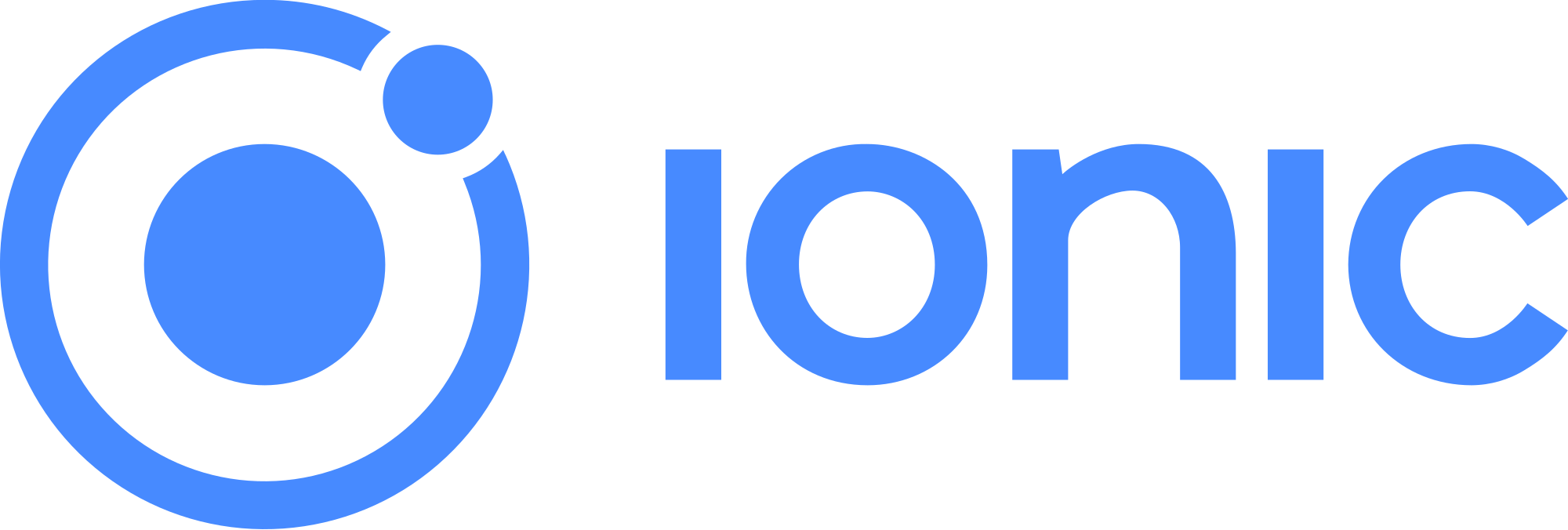Get started with

Create mobile apps with
web technologies you already know.
Ionic offers a library of mobile-optimized
HTML, CSS and JS components, gestures, and tools for building cross-platform apps.




Your App
Ionic
Angular
Webview (Cordova)
Native SDK
Tabs
Side menu
Ready? Set. Go!
$ npm install -g cordova ionic$ ionic start myApp blank
// or use ready-made app templates: tabs, sidemenu
$ ionic start myApp tabs $ cd myApp
$ ionic platform add android
$ ionic build android
$ ionic emulate android1. Install Ionic
2. Start project
3. Run it
← index.html
← app.js
blankapp
├───hooks
├───plugins
├───scss
└───www
├───css
├───img
├───js
│ └───app.js
├───lib
│ └───ionic
│ ├───css
│ ├───fonts
│ ├───js
│ │ ├───angular
│ │ └───angular-ui
│ └───scss
│ └───ionicons
└───index.htmlBuilding blocks
index.html
<!DOCTYPE html>
<html>
<head>
<meta charset="utf-8">
<meta name="viewport" content="initial-scale=1,
maximum-scale=1, user-scalable=no, width=device-width">
<title></title>
<link href="lib/ionic/css/ionic.css" rel="stylesheet">
<link href="css/style.css" rel="stylesheet">
<script src="lib/ionic/js/ionic.bundle.js"></script>
<script src="cordova.js"></script>
<script src="js/app.js"></script>
</head>
<body ng-app="starter">
<ion-pane>
<ion-header-bar class="bar-stable">
<h1 class="title">Ionic Blank Starter</h1>
</ion-header-bar>
<ion-content>
</ion-content>
</ion-pane>
</body>
</html>
app.js
// Ionic Starter App
angular.module('starter', ['ionic'])
.run(function($ionicPlatform) {
$ionicPlatform.ready(function() {
// Hide the accessory bar by default
if(window.cordova && window.cordova.plugins.Keyboard) {
cordova.plugins.Keyboard
.hideKeyboardAccessoryBar(true);
}
if(window.StatusBar) {
StatusBar.styleDefault();
}
});
});index.html
<!DOCTYPE html>
<html>
<head><!-- meta, links, and scripts --></head>
<body ng-app="starter">
<ion-pane ng-controller="ListCtrl">
<ion-header-bar class="bar-stable">
<h1 class="title">Listy</h1>
<button class="button button-icon ion-plus"
ng-click="addItem()"></button>
</ion-header-bar>
<ion-content>
<ion-list>
<ion-item ng-repeat="item in items">
{{ item.name }}
</ion-item>
</ion-list>
</ion-content>
</ion-pane>
</body>
</html>app.js
// Ionic Starter App
angular.module('starter', ['ionic'])
.run(function($ionicPlatform) { ... })
// Added controller for list
.controller('ListCtrl', function($scope) {
$scope.items = [
{name: 'Eggs'},
{name: 'Bacon'},
{name: 'Sausage'},
{name: 'Butter'},
{name: 'English muffins'}
];
$scope.addItem = function() {
var name = prompt("What do you need to buy?");
if (name) {
$scope.items.push({
"name": name
});
}
};
})

Static content and
hard-coded values???

Realtime database designed for
use on the client
Read from/write to Firebase instance
// index.html
<!-- Firebase -->
<script src="libs/firebase/2.2.4/firebase.js"></script>
<!-- AngularFire -->
<script src="libs/angularfire/1.1.2/angularfire.min.js"></script>
<body ng-app="starter">
<ion-pane ng-controller="ListCtrl">
<ion-header-bar class="bar-stable">
<h1 class="title">Listy</h1>
<button class="button button-icon ion-plus" ng-click="addItem()">
</button>
</ion-header-bar>
<ion-content>
<ion-list>
<ion-item ng-repeat="item in items">
{{ item.name }}
</ion-item>
</ion-list>
</ion-content>
</ion-pane>
</body>angular.module('starter', ['ionic', 'firebase']) //include dependencies
.value('URL', 'https://fedbb.firebaseio.com/') // Create Angular const.
.factory('Firebase', function($firebase, URL){ // Firebase factory
return new Firebase(URL);
})
.factory('Items', function(Firebase, $firebaseArray) { // Items factory
var itemsRef = Firebase.child('items');
return $firebaseArray(itemsRef);
})
.run(function($ionicPlatform) { ... })
.controller('ListCtrl', function($scope, Items) { // dependencies
$scope.items = Items;
$scope.addItem = function() {
var name = prompt("What do you need to buy?");
if (name) {
$scope.items.$add({ // Add new values to Items
"name": name
});
}
};
});Read from/write to Firebase instance
// index.html
<body ng-app="starter">
<ion-pane ng-controller="ListCtrl">
<ion-header-bar class="bar-stable">
<h1 class="title">Listy</h1>
<button class="button button-icon ion-plus"
ng-click="addItem()">
</button>
</ion-header-bar>
<ion-content>
<ion-toggle ng-model="shouldShowDelete">
Edit
</ion-toggle>
<ion-list show-delete="shouldShowDelete">
<ion-item ng-repeat="item in items">
<ion-delete-button class="ion-minus-circled"
ng-click="deleteItem(item)">
</ion-delete-button>
{{ item.name }}
</ion-item>
</ion-list>
</ion-content>
</ion-pane>
</body>Read from/write to Firebase instance
// app.js
angular.module('starter', ['ionic', 'firebase'])
...
.controller('ListCtrl', function($scope, Items) {
$scope.items = Items;
$scope.addItem = function() { ... };
$scope.deleteItem = function (item) { // Add delete method
$scope.items.$remove(item);
}
});Read from/write to Firebase instance
Add a side menu
- Switch to ion-nav-view
- Move from single html file to templates
- menu.html
- list.html
- Create ngConfig using $stateProvider and $urlRouterProvider
- Wire everything up
Add a login modal for auth
- Create login.html template
- Create firebaseAuth factory
-
Create new Login controller (LoginCtrl)
-
Include $ionicModal service
- At this point, I create a separate controllers.js file
-
Include $ionicModal service
- Wire up functions to open/close modal
- Wire up doLogin to use firebaseAuth
- Test
Add a signup page for new users
- Create signup.html template
- Create Signup controller (SignupCtrl)
- Wire up functions to create new user onSubmit
- Create new state in app config
- Test
Add some style
1. Setup Sass automagically
$ ionic setup sass$positive: #1b88b0 !default;
$balanced: #9cbe30 !default;
$calm: #b8d94c !default;
$assertive: #e57770 !default;
$dark: #443f39 !default;2. Add custom styles to ionic.app.scss
This is you

(hopefully)
Resources
- Ionic - Getting started
- Firebase Ionic guide
- Firebase Email & Password authentication
- AngularFire API docs
- Ionic - Sass Customization
- AngularJS Up and Running (Safari Books online)
- Structuring NoSQL data
-
Deploying apps to iOS devices
- No longer requires Apple Developer License (Xcode 7 beta)
- Deploying apps to Android devices
- "Building apps with Angular and Ionic"
Ionic Brownbag
By Carlos Filoteo
Ionic Brownbag
- 725



